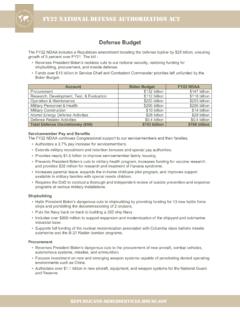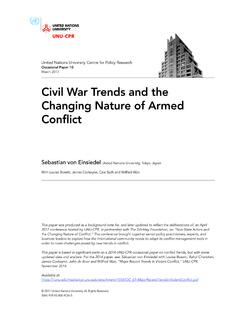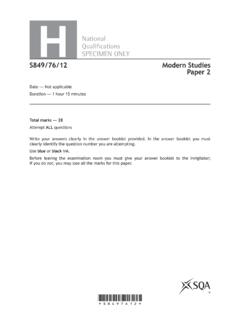Transcription of The Islamic State and U.S. Policy
1 The Islamic State and Policy Christopher M. Blanchard Specialist in Middle Eastern Affairs Carla E. Humud Analyst in Middle Eastern and African Affairs February 2, 2017. Congressional Research Service 7-5700. R43612. The Islamic State and Policy Summary The Islamic State (IS, aka the Islamic State of Iraq and the Levant, ISIL/ isis , or the Arabic acronym Da'esh) is a transnational Sunni Islamist insurgent and terrorist group that controls large areas of Iraq and Syria, has affiliates in several other countries, has attracted a network of global supporters, and disrupts international security with its campaigns of violence and terrorism.
2 The coalition military campaign against the Islamic State organization in Iraq and Syria has adapted since 2014, as Administration officials and coalition partners have implemented changes in strategy and tactics that have reduced the area controlled by the group and eliminated thousands of its personnel. While the Islamic State has suffered losses on the ground in Iraq, Syria, and Libya, a series of terrorist attacks attributed to the group or to individuals it has inspired have claimed hundreds of lives on four continents since November 2015, including in the United States. A number of countries, including the United States, share an interest in further weakening the group and preventing future attacks.
3 Members of Congress, executive branch officials, and their international counterparts continue to debate a range of proposals for extending battlefield gains made to date and preventing the Islamic State from succeeding in its stated objectives of remaining and expanding. President Obama's goals for strategy were to degrade and ultimately defeat the Islamic State through direct military action and support for local partner forces. The military has conducted operations against the group in Iraq, Syria, and Libya. Parallel diplomatic efforts have promoted political reconciliation in each country among local factions.
4 In other countries, such as Egypt and Nigeria, the United States provides security assistance to partner governments in support of operations against Islamic State affiliates. Evolving counterterrorism cooperation and intelligence sharing efforts among a wider network of concerned governments seek to further limit the ability of IS supporters to carry out transnational terrorist attacks. President Donald Trump has directed his Administration to develop a comprehensive plan to defeat the group. The interdependent nature of conflicts and political crises in Iraq, Syria, and other countries where the Islamic State operates complicates efforts to address and durably eliminate the threats posed by the group.
5 Military operations may eliminate IS fighters and liberate IS-held territory, but underlying political disputes and development challenges that have been exploited by the Islamic State and other extremist groups may remain unaddressed or become amplified if post- conflict reconciliation and reconstruction needs go unmet. Governments may continue to share fears about IS-related transnational terrorist threats, but leaders also may continue to face difficult decisions about the potential risks and rewards of military, law enforcement, surveillance, intelligence sharing, financial, border security, refugee admission, and consular countermeasures.
6 This report provides background on the Islamic State organization, discusses its goals, operations, and affiliates, reviews legislative and Policy debates, and describes select FY2017 legislation from the 114th Congress ( 5325, 2028, S. 2943, 5293, and S. 3000). For more information, see CRS Report R44513, Kurds in Iraq and Syria: Partners Against the Islamic State , coordinated by Jim Zanotti; CRS Report R43980, Islamic State Financing and Policy Approaches, by Carla E. Humud, Robert Pirog, and Liana W. Rosen; CRS Report R44135, Coalition Contributions to Countering the Islamic State , by Kathleen J. McInnis; CRS Report R43760, A New Authorization for Use of Military Force Against the Islamic State : Issues and Current Proposals, by Matthew C.
7 Weed; CRS Report R44003, European Fighters in Syria and Iraq: Assessments, Responses, and Issues for the United States, coordinated by Kristin Archick;. and CRS Report R44519, Overseas Contingency Operations Funding: Background and Status, coordinated by Susan B. Epstein and Lynn M. Williams. Congressional Research Service The Islamic State and Policy Contents The Islamic State .. 1. Posture and Threat Assessments .. 1. Key 2016 Developments .. 4. 2017 Outlook .. 5. Responding to the Islamic State 's Global Expansion 5. Responding to the Islamic State 's Transnational Terrorist Attacks .. 7. Strategy, Policy Options, and Related Issues.
8 8. Combatting the Islamic State in Complex Contexts .. 9. Military Operations against the Islamic State .. 10. Partnership Programs .. 10. Training, Equipping, and Advising Partners in Iraq .. 10. Efforts to Train, Equip, and Advise 11. Humanitarian Funding and Post-IS Stabilization and Reconstruction .. 12. Man-Portable Air Defense Systems (MANPADS) .. 12. Legislative Debates in the 114th 13. FY2017 Appropriations Requests and Legislation .. 13. FY2017 Authorization 14. Select Issues for the 115th Congress .. 14. Debating Overall Strategy .. 14. Outlook .. 16. Figures Figure 1. Syria and Iraq: Areas of Influence.
9 3. Figure A-1. Timeline: The Roots of the Islamic State .. 20. Figure C-1. The Extinction of the Gray Zone .. 27. Appendixes Appendix A. Emergence and Organizational Development .. 18. Appendix B. IS Affiliates and Adherents .. 21. Appendix C. Ideology and Operations .. 26. Contacts Author Contact Information .. 32. Congressional Research Service The Islamic State and Policy The Islamic State The Islamic State organization (IS, aka the Islamic State of Iraq and the Levant, ISIL/ isis , or the Arabic acronym Da'esh)1 emerged as a major international security threat amid more than a decade of conflict in Iraq and the outbreak of conflict in Syria (see Appendix A).
10 The group's core membership remains in Iraq and Syria, and its efforts have been bolstered by a network of foreign fighters and affiliate groups in several countries across the Middle East, Africa, and Asia (see Appendix B). The Islamic State 's apocalyptic ideology, its revolutionary intent toward the strategically important Middle East, and its embrace of transnational terrorism have alarmed policymakers around the world and spurred global debate over strategies and Policy options for defeating the group. Posture and Threat Assessments As of January 2017, the Islamic State continues to occupy areas of northern and western Iraq and northern and eastern Syria (see Figure 1).

















